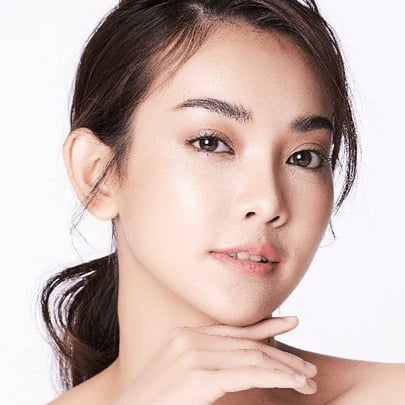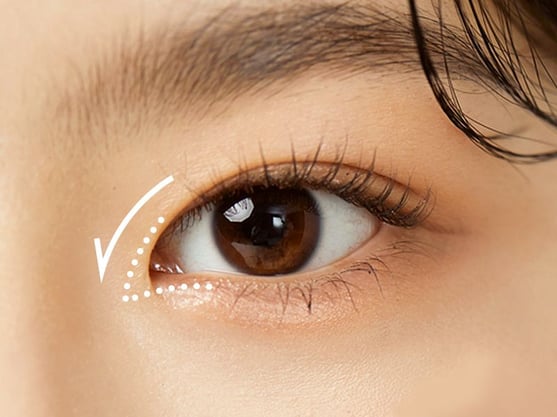Articles
Types of Eyelids and Epicanthoplasty In Singapore
What makes an attractive eye?
‘The eye is the jewel of the body’ Henry David Thoreau
More than any other feature on the face, the eyes are what first captures our attention. It is the most expressive part of our face and is the window to our thoughts and emotions.
Commonalities in attractive eyes are bright and engaging appearance that displays warmth. Features of appealing eyes include appropriate dimensions which frame the iris, a crisp upper eyelid fold at the appropriate height, and adequate volume without hollowing or puffiness.
Most importantly, each individual’s eyes are unique and should blend harmoniously with the rest of the facial features.

What are double eyelids?
Regional physiological characteristics
A double eyelid is defined as an upper eyelid where a skin fold forms when the eye is open. This happens due to a crease formed by fibrous attachments between the eyelid elevating muscles and the skin, thus when we open our eyes, these attachments pull on the skin forming the double eyelid. In East Asian anatomy, this crease is usually lower or even absent, with excess eyelid fat and heavy skin, which usually leads to a lower or absent fold. The resultant appearance leads to a tired, sleepy, or dull look with a narrow eye opening. This is often combined with a thick medial epicanthal fold, which can make the eye appear even smaller. Quite often, even East Asians with double eyelids can experience a disappearance of their folds. This is because the attachments of the muscle to the skin are weak or low, which leads to a hidden double eyelid or one that sometimes disappears due to conditions that cause mild swelling of the eyelid, such as crying or lack of sleep.
Ptosis correction and double eyelid surgery
Another benefit of a well-formed, crisp double eyelid fold is that it can make the eyes appear larger and brighter. Occasionally, an absent or low double eyelid fold can be associated with ptosis, which can be a medical condition of droopy eyelids. If this happens, part of the procedure that needs to be done would be raising the eyelid as well as creating the double eyelid fold. Double eyelid surgery can also make the eyes look bigger when combined with procedures that widen the horizontal appearance of the eyes, also known as medial or lateral epicanthoplasty. These procedures also serve to improve the overall result of double eyelid surgery.
Non-incisional double eyelid creation
The direct suture technique, also known as stitch/suture/non-incisional double eyelid surgery is a minimally invasive form of double eyelid creation. It utilizes puncture marks with a needle, and precise placement of fine sutures to bring the eyelid skin, muscle, and supporting cartilage together to create the double eyelid crease. It can be easily performed under local anaesthetic in the clinic and is associated with very little bruising or swelling. There is also the ability to correct mild forms of ptosis with this procedure. However, there is a risk of disappearance of the double eyelid through breakage of the sutures, which is more common in heavier upper eyelids. Also, as the skin cannot be removed and there is a limitation to the amount of fat that can be taken out, it is not suitable for all upper eyelids. Other potential complications include asymmetries and eye irritative symptoms from the sutures. These are rare and easily corrected. In the right patients, non-incisional double eyelid surgery can yield great, lasting results with minimal downtime. Non-incisional double eyelid creation can be combined with medial epicanthoplasty if required.
Incisional double eyelid creation
In incisional double eyelid surgery, the skin incision is placed where the eventual double eyelid crease will be. This method of ‘opening’ the upper eyelid allows the anatomy to be clearly elucidated, and precise fixation of upper eyelid structures can be done to create a lasting, natural crease. In addition, this approach enables the excision of excess skin, fat, and other soft tissues. Compared with suture blepharoplasty, bruising, swelling and overall recovery time will be a couple of weeks longer. However, it is the most powerful way of creating the double eyelid crease and affords the most adjustability and ability to combine with epicanthoplasty procedures.
Types of Double Eyelids
Double eyelids are formed during eye opening by fibrous attachments to the skin from the muscle that elevates the eye (LPS). You will know that you have double eyelids when you can see a fold appear above your eye when you look in the mirror. In some individuals, this fold can be very low, almost giving the appearance of no double eyelid at all. In others, due to multiple or varied attachments to the skin from the LPS muscle,
There are multiple types of double eyelids, and no one type suits everyone’s faces. However, the basic components of double eyelid appearance can be distlled into 3 areas:
1. Where the double eyelid fold begins
This refers to where the double eyelid line starts in relation to the innermost portion of the eye (the medial epicanthus).
a) An outfold refers to a double eyelid which begins away from the medial epicanthusb) An onfold refers to a double eyelid which begins right on the medial epicanthus
c) An infold refers to a double eyelid which arises after an overlapping medial epicanthal fold. This sort of medial epicanthal fold is common in Asians and can be addressed via a medial epicanthoplasty procedure along with the double eyelid procedure
2. The shape of the double eyelid as it travels outwards along the upper eyelid margin
There are 2 main shapes:
- A parallel fold refers to a fold that runs parallel along the entire upper eyelid margin from inside to out- A tapered fold refers to one which gradually grows wider along the upper eyelid margin from inside to out
3. The height of the double eyelid
The height of the double eyelid is determined by the height at which the crease is placed. In East Asians, this is usually between 5-8mm from the upper eyelid margin. In caucasians, this is usually higher from about 1cm.
By combining these three factors and tailoring them to an individual’s facial features, a pleasing double eyelid can be created. This can potentially be achieved with both the non-incisional and incisional methods.
What is Medial Epicanthoplasty?
Medial epicanthoplasty refers to the widening of the eyelid opening towards the nose by surgically modifying the medial epicanthal fold. It helps to reveal more of the inner part of the eye, also known as the lacrimal lake, and removes the thick fold which makes the eyes appear wider apart. This also helps to position where the double eyelid fold begins at its inner point, and contributes towards creating a beautiful double eyelid.

There are many methods described for medial epicanthoplasty. The procedure which suits each patient depends on whether excess skin from the medial epicanthal fold is present more at the upper or lower eyelid. The aim is to widen the medial part of the eye to show enough of the lacrimal lake, whilst minimizing scars. This is because while the upper eyelid scar can be hidden when the eye is open, the medial epicanthoplasty scar is potentially always visible. It usually takes about 4-6 weeks for medial epicanthoplasty to scars to heal imperceptibly. Done well, medial epicanthoplasty scars are barely visible even on close inspection.
Once performed, medial epicanthoplasty is difficult to reverse. While a medial epicanthal fold can be created by shifting tissue from around the inner eyelid skin, it is much more difficult to replace what is lost than to remove, and should only be done with much consideration.
What is Lateral Epicanthoplasty?
Lateral epicanthoplasty is the widening of the eye horizontally by surgically modifying the outer part of the eye aperture, This procedure can be done to reveal more of the whitish surface of the eye laterally (scleral show), or to reposition the lateral corner of the eye higher or lower.
Lateral epicanthoplasty can be performed via incisions on the inside of the eyelid (conjunctiva), on the skin of the outer part of the eye, or a combination of both. It is a more difficult procedure than medial epicanthoplasty, and can potentially lead to eversion of the lower eyelid margin showing the red of the conjunctiva. Once performed, lateral epicanthoplasty is difficult to reverse.
What to expect from your double eyelid procedure?
Preparation
With the appropriate choice of procedure, double eyelid surgery should give you, pleasing, symmetrical, and lasting results. It is also imperative that your comfort and eye safety are well taken care of. while ensuring your comfort and safety. Your doctor should give you instructions about how to prepare and recover for double eyelid surgery before and after the procedure, such that healing time is quickened.
About procedure
The large majority of double eyelid procedures can be done under local anaesthesia in the clinic. A small injection will be administered underneath the skin, and within seconds the area will be numb. The chosen procedure will only proceed once you are comfortable. You will be monitored in the clinic for a brief period after to ensure your safety before going home.
Recovery
In the first few days after the procedure, there will be swelling and mild bruising at the surgical site. A post-operative protocol such as a cold compress and/or medication can help with these. There are usually stitches placed to close the skin, which are removed within the week after the procedure.
The majority of swelling will resolve by 1-2 weeks, and the final long-term result is usually seen at 2 months after surgery. Whilst perfection is always the goal in one sitting, any obvious residual asymmetries can be corrected at this point with a minor procedure.
Possible risks and complications
The risks of double eyelid surgery include mild pain and infection, which are very minimal and usually controlled well with medication. A potentially more serious complication is bleeding in the immediate post-procedural period, which may require reopening of the wounds to stop. This is exceedingly rare. In general, double eyelid surgery is very safe when performed by a qualified plastic surgeon. Whilst there are no procedures without complications, those that happen are fortunately rare and treatable.
Conclusion
Done well, double eyelid surgery can last you a lifetime. Do note that the incisional upper blepharoplasty technique, due to its ability to precisely correct anatomy, has a higher chance of a long-lasting result than the suture upper blepharoplasty technique. Patients making the eyelid correction might consider a lower eyelid correction as well, for that case a procedure of lower blepharoplasty will be applied.Contact Form
1 Orchard Boulevard #10-08 Camden Medical Centre, Singapore 248649
6 Napier Rd, #08-01 Gleneagles Medical Center, Singapore 258499
Tel: +65 6737 4565 | Mobile: +65 8828 4565 | Email: clinic@polarisplasticsurgery.com | Business Hours: Mon - Fri: 9am - 6pm | Sat: 9am - 1pm | Sun/Ph: Closed












